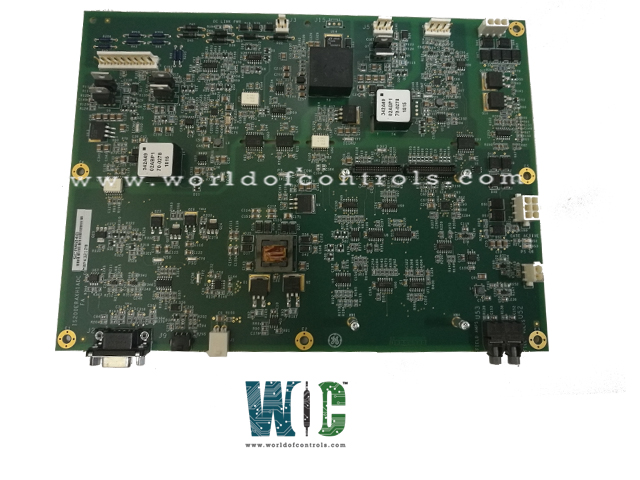
World Of Controls understands the criticality of your requirement and works towards reducing the lead time as much as possible.
IS200ERAXH1ADC - Exciter Auxiliary I/O Interface Board is available in stock which ships the same day.
IS200ERAXH1ADC - Exciter Auxiliary I/O Interface Board comes in UNUSED as well as REBUILT condition.
To avail our best deals for IS200ERAXH1ADC - Exciter Auxiliary I/O Interface Board, contact us and we will get back to you within 24 hours.
SPECIFICATIONS:
Part Number: IS200ERAXH1ADC
Manufacturer: General Electric
Series: EX2100e
Product Type: Exciter Auxiliary I/O Interface Board
Number of channels: 12
Input span: 4-20 mA
Technology: Surface Mount
Common Mode Voltage Range: ±5 V
Maximum Lead Resistance: 15Ω
Analog output current: 0-20 mA
Operating temperature: -30 to 65 °C
Size: 8.26 cm high x 4.19 cm
Repair: 3-7 Day
Availability: In Stock
Country of Origin: United States
Manual: GEA-S1301A
FUNCTIONAL DESCRIPTION:
IS200ERAXH1ADC is an Exciter Auxiliary I/O Interface Board manufactured and designed by General Electric as part of the EX2100e Series used in GE Excitation Control Systems. The EX2100e Excitation Control Regulator system is GE’s most recent state-of-the-art control system for steam, gas, or hydro generators for both new and retrofit units. Control hardware and software design is closely coordinated between GE’s system and controls engineering to ensure the delivery of a true system solution. Integration is seamless between Excitation Control systems, Turbine Control systems, Static Starter Control systems, Integrated Control Systems (ICS), and the Human-machine Interface (HMI). For stand-alone retrofit applications, integration with customer-distributed control systems (DCS) through serial or Modbus Ethernet is supported. This document specifically addresses applications for the 35 A and 120 A (nominal) series of EX2100e Control Regulator systems.
CONTROL HARDWARE:
The EX2100e Regulator system is available in several configurations to provide control flexibility for Thyristor and Regulator systems. For small Regulator systems, two pulse-width modulated (PWM) power converter modules use Insulated Gate Bipolar Transistors (IGBT) to provide up to 35 A or 120 A nominal output. These systems can support the following applications:
In the SCT/PPT regulator and dc rotating exciter regulator applications, the EX2100e Regulator system can de-sensitize the effect of the exciter time constant. It incorporates direct measurement of the generator field voltage and field current to enhance the speed of response to system transients.
POWER CONVERSION MODULE:
The Power Conversion Module (PCM) consists of an integrated IGBT inverter module that contains six IGBTs connected in a 3-phase inverter configuration. Two of the six IGBTs are used to create the PWM dc output for field excitation. A third IGBT is used to discharge the dc link capacitors into an external DD resistor to prevent overvoltage.
CONTROL SOFTWARE:
The EX2100e control software supports high performance and helps the customer and field engineers understand, install, commission, tune, and maintain the excitation control system. The exciter software is configured and loaded from the ToolboxST application and resides in the controllers. The software is represented on the ToolboxST Component Editor screen by control blocks that are linked together to display the signal flow. The generator voltages and currents from the PTs and CTs are the source of the control signals needed by the automatic (generator terminal voltage) regulator, most limiters, and protection functions. They are wired to the ESYS, which acts as a signal conditioner to isolate and scale the signals. The conditioned signals are fed to the controller. The system simultaneously samples the ac waveform at high speed and uses advanced mathematical algorithms to digitally generate the needed variables. The output of the software transducer system includes the following:
WOC has the largest stock of GE Excitation Control System Replacement Parts. We can also supply unused and rebuilt backed-up with a warranty. Our team of experts is available round the clock to support your OEM needs. Our team of experts at WOC is happy to assist you with any of your automation requirements. For pricing and availability on any parts and repairs, kindly get in touch with our team by phone or email.
What is the Exciter Auxiliary I/O Interface Board?
The Exciter Auxiliary I/O Interface Board is a component used in various electronic systems, typically in exciter systems. It facilitates communication and control between the exciter and external devices or systems through input/output (I/O) connections.
What types of connections does the Interface Board support?
The Interface Board typically supports various types of connections, including analog and digital inputs and outputs, serial communication ports (such as RS-232 or RS-485), and possibly other custom interfaces depending on the specific requirements of the exciter system.
What are the typical applications of the Exciter Auxiliary I/O Interface Board?
The Interface Board finds applications in various industries where exciter systems are used, such as power generation, industrial automation, and research laboratories. It can be employed in controlling and monitoring processes, data acquisition, and interfacing with other equipment or systems.